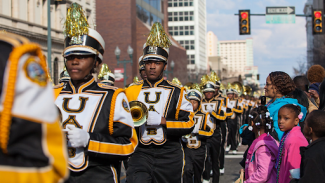
While other schools wanted their marching bands to be as militaristic as possible, HBCUs knew that to create a sensation, their bands had to add their own flair. And that creativity brought Black marching bands to worldwide fame.
Black marching bands draw influence from the 13th-century Yoruba tradition, where Egun masqueraders danced and played music during funeral processions. As time progressed, our creativity continued to lay the foundation for today’s Black marching bands.
Dating back to the Revolutionary War, Black soldiers weren’t allowed to carry weapons so they used their creativity to build morale on the battlefield by playing musical instruments. Over time, these musicians brought what they learned back to their communities.
Tuskegee Normal and Industrial Institute is widely considered the first HBCU with a marching band. However, Florida A&M (FAMU) changed the game in 1946 when bandleader Dr. William Foster introduced steps and high-knee lifts during practice – making creative expression and showmanship a key part of the experience.
HBCU marching bands have revolutionized music and entertainment, but they wouldn’t have the spectacles they are today if it wasn’t for our ability to creatively reshape the way we look at music. Imagine what else we can use our culture to achieve when it comes to our liberation.